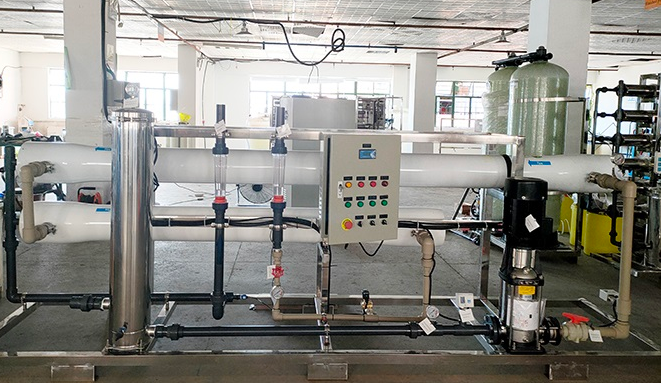
Wechat/Whatsapp:
+8613798883773

Wechat/Whatsapp:
+8613798883773
HYWATER Reverse Osmosis plant/system


Fault diagnosis of Reverse osmosis system Membrane element failure usually manifests itself in phenomena such as degradation of membrane performance, physical damage, and chemical degradation; the more representative phenomenon is the decrease in the desalination rate of the membrane element (increased water conductivity), and the change in water production (increased operating pressure) Or decrease) and pressure loss (differential pressure) increase. When the membrane system is found to be faulty, it is necessary to consult the operation records and analyze the quality of the raw water in time to obtain the correct judgment: 1. Check the operating records and investigate whether there are abnormal operating conditions; if the parameters are standardized in the form of graphs when recording data daily, it will be much more convenient to check 2. Add the necessary data. If the performance of the system is reduced, you can disassemble the membrane element that has the problem, and check its appearance and the condition of the sealing ring of the connector. The measurement of the performance of each membrane element and the location of the detection point for leaks at the seal of the connecting pipe are as follows:-Upstream of the membrane element: confirmation of the seal of the connecting pipe (20 mm downstream of the O-ring seal, more than 60 mm, It will communicate with the opening of the central water collection pipe, and the result will be affected by the performance of the membrane). -Membrane element center: measurement of membrane element performance. -Downstream of the membrane element: Confirmation of the seal of the connecting pipe. To check which part of the membrane element filled in each pressure vessel has decreased salt rejection, you can use the probe method (online detection) or extraction detection method (offline detection); the probe method uses a plastic tube inserted into the central water collection pipe and penetrates The full-length method is to test the conductivity of water produced by membrane elements at different positions. The product water sampled comes from the product water upstream of the front end of the hose, indicating the water quality at the front end of the hose. 3. Investigation and analysis of the characteristics of raw water; the detection of raw water should try to analyze the substances that will affect the performance of the membrane as much as possible, regarding SS or particulates, fouling substances (calcium, silicon, bicarbonate and sulfate ions, etc.) ) 4. Perform performance inspection of the membrane element removed from the device, and inspect the disassembly of the membrane element The performance test of membrane element includes the following inspection items: -Vacuum maintenance inspection and watertight inspection can determine the damage and location of the flat film; -Re-test membrane elements under standard test conditions and compare changes in salt rejection, water production, and pressure difference to determine membrane damage, membrane performance degradation, pollution, flow path blockage, and poor contact with connectors. The above performance test data is compared with the factory data to confirm the performance change status. The pressure difference detector is used in the measurement of the pressure difference, and the accuracy of 0.001 MPa must be achieved in the test. 5. Pay attention to the diagnosis of each pressure vessel: Observing the performance data of each pressure vessel is very important to find out the cause of the system failure. Failures such as poor sealing of connectors and sealing rings or damage to membrane elements will cause the performance of the pressure vessel as a unit to decline. The system is in the first and second paragraphs. Whether the membrane elements of the second stage have similar performance degradation also explains different reasons for the failure; if the performance data cannot be obtained in sections, test each pressure vessel, usually to test the conductivity of the produced water in each pressure vessel, and when sampling Pay attention to investigate the piping installation method, whether the product water of the pressure vessel being measured is affected by the product water of other pressure vessels 6. Chemical cleaning test: In order to estimate pollutants and determine the degree of membrane degradation, a chemical cleaning test is required. The type of dirt can be deduced from the effect of chemical cleaning. In order to select the appropriate chemicals, the membrane elements can be disassembled, and a flat membrane sample can be taken for a chemical cleaning test. The flat membrane sample after the membrane disintegration can be made into a sample of Φ75 mm, soaked with chemical reagents at room temperature for 8 hours, and then the flat membrane performance test is carried out with the blank sample (the membrane soaked in pure water) to judge the effect of chemical cleaning. Finally, the effective chemical reagents are determined, so as to roughly infer the types of pollutants, which can then guide the cleaning of contaminated membrane elements. More inquiries related to Reverse osmosis system please contact: Mob& Wechat& WhatsApp: (+86)13544774483 Email: sales010@water-sy.com We will provide high-quality, all-round comprehensive professional services for project consulting, system design, manufacturing, installation and commissioning, personnel training, etc
